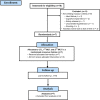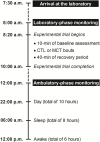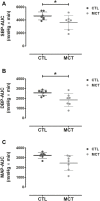Acute effects of mixed circuit training on hemodynamic and cardiac autonomic control in chronic hemiparetic stroke patients: A randomized controlled crossover trial
- PMID: 35928565
- PMCID: PMC9343773
- DOI: 10.3389/fphys.2022.902903
Acute effects of mixed circuit training on hemodynamic and cardiac autonomic control in chronic hemiparetic stroke patients: A randomized controlled crossover trial
Abstract
Objectives: To investigate whether a single bout of mixed circuit training (MCT) can elicit acute blood pressure (BP) reduction in chronic hemiparetic stroke patients, a phenomenon also known as post-exercise hypotension (PEH). Methods: Seven participants (58 ± 12 years) performed a non-exercise control session (CTL) and a single bout of MCT on separate days and in a randomized counterbalanced order. The MCT included 10 exercises with 3 sets of 15-repetition maximum per exercise, with each set interspersed with 45 s of walking. Systolic (SBP) and diastolic (DBP) blood pressure, mean arterial pressure (MAP), cardiac output (Q), systemic vascular resistance (SVR), baroreflex sensitivity (BRS), and heart rate variability (HRV) were assessed 10 min before and 40 min after CTL and MCT. BP and HRV were also measured during an ambulatory 24-h recovery period. Results: Compared to CTL, SBP (∆-22%), DBP (∆-28%), SVR (∆-43%), BRS (∆-63%), and parasympathetic activity (HF; high-frequency component: ∆-63%) were reduced during 40 min post-MCT (p < 0.05), while Q (∆35%), sympathetic activity (LF; low-frequency component: ∆139%) and sympathovagal balance (LF:HF ratio: ∆145%) were higher (p < 0.001). In the first 10 h of ambulatory assessment, SBP (∆-7%), MAP (∆-6%), and HF (∆-26%) remained lowered, and LF (∆11%) and LF:HF ratio (∆13%) remained elevated post-MCT vs. CTL (p < 0.05). Conclusion: A single bout of MCT elicited prolonged PEH in chronic hemiparetic stroke patients. This occurred concurrently with increased sympathovagal balance and lowered SVR, suggesting vasodilation capacity is a major determinant of PEH in these patients. This clinical trial was registered in the Brazilian Clinical Trials Registry (RBR-5dn5zd), available at https://ensaiosclinicos.gov.br/rg/RBR-5dn5zd. Clinical Trial Registration: https://ensaiosclinicos.gov.br/rg/RBR-5dn5zd, identifier RBR-5dn5zd.
Keywords: autonomic nervous system; blood pressure; circuit-based exercise; exercise; rehabilitation.
Copyright © 2022 Fonseca, Midgley, Billinger, Michalski, Costa, Monteiro, Farinatti and Cunha.
Conflict of interest statement
The authors declare that the research was conducted in the absence of any commercial or financial relationships that could be construed as a potential conflict of interest.
Figures





Similar articles
-
Mixed circuit training acutely reduces arterial stiffness in patients with chronic stroke: a crossover randomized controlled trial.Eur J Appl Physiol. 2023 Jan;123(1):121-134. doi: 10.1007/s00421-022-05061-8. Epub 2022 Oct 7. Eur J Appl Physiol. 2023. PMID: 36205814 Clinical Trial.
-
Hemodynamics and cardiac autonomic modulation after an acute concurrent exercise circuit in older individuals with pre- to established hypertension.Clinics (Sao Paulo). 2021 Jan 20;76:e1971. doi: 10.6061/clinics/2021/e1971. eCollection 2021. Clinics (Sao Paulo). 2021. PMID: 33503175 Free PMC article.
-
Is postexercise hypotension a method-dependent phenomenon in chronic stroke? A crossover randomized controlled trial.Clin Physiol Funct Imaging. 2023 Jul;43(4):242-252. doi: 10.1111/cpf.12812. Epub 2023 Jan 23. Clin Physiol Funct Imaging. 2023. PMID: 36646496 Clinical Trial.
-
Acute and chronic effects of traditional and high-speed resistance training on blood pressure in older adults: A crossover study and systematic review and meta-analysis.Exp Gerontol. 2022 Jun 15;163:111775. doi: 10.1016/j.exger.2022.111775. Epub 2022 Mar 25. Exp Gerontol. 2022. PMID: 35346759
-
Post-exercise Hypotension Following a Single Bout of High Intensity Interval Exercise vs. a Single Bout of Moderate Intensity Continuous Exercise in Adults With or Without Hypertension: A Systematic Review and Meta-Analysis of Randomized Clinical Trials.Front Physiol. 2021 Jun 28;12:675289. doi: 10.3389/fphys.2021.675289. eCollection 2021. Front Physiol. 2021. PMID: 34262474 Free PMC article.
Cited by
-
Blood pressure and heart rate variability to assess autonomic response to an acute bout of high intensity interval exercise in healthy young adults.Physiol Rep. 2024 Jul;12(14):e16142. doi: 10.14814/phy2.16142. Physiol Rep. 2024. PMID: 39054267 Free PMC article.
References
-
- ACSM (2013). ACSM's guidelines for exercise testing and prescription. Baltimore: Lippincott Williams & Wilkins.
-
- Anunciação P. G., Farinatti P. T., Goessler K. F., Casonatto J., Polito M. D. (2016). Blood pressure and autonomic responses following isolated and combined aerobic and resistance exercise in hypertensive older women. Clin. Exp. Hypertens. 38 (8), 710–714. 10.1080/10641963.2016.1200601 - DOI - PubMed
-
- Berg K., Wood-Dauphinee S., Williams J. (1995). The balance scale: Reliability assessment with elderly residents and patients with an acute stroke. Scand. J. Rehabil. Med. 27 (1), 27–36. - PubMed
-
- Billinger S. A., Arena R., Bernhardt J., Eng J. J., Franklin B. A., Johnson C. M., et al. (2014). Physical activity and exercise recommendations for stroke survivors: A statement for healthcare professionals from the American heart association/American stroke association. Stroke 45 (8), 2532–2553. 10.1161/STR.0000000000000022 - DOI - PubMed
LinkOut - more resources
Full Text Sources
Research Materials
Miscellaneous

